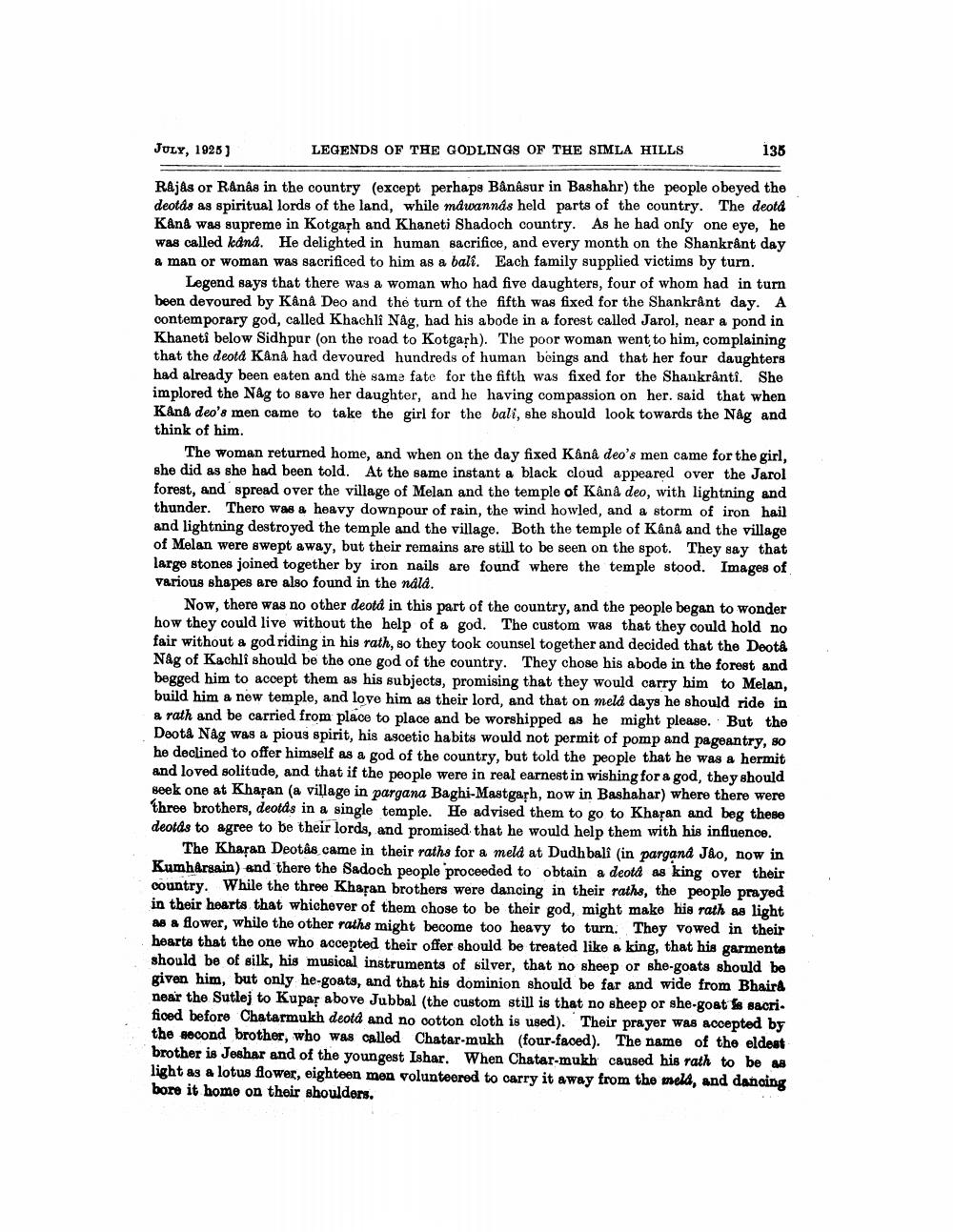________________
JULY, 1925)
LEGENDS OF THE GODLINGS OF THE SIMLA HILLS
135
Rajas or Rands in the country (except perhaps Bån sur in Bashahr) the people obeyed the deotds as spiritual lords of the land, while mdwannds held parts of the country. The deota Kand was supreme in Kotgarh and Khaneti Shadoch country. As he had only one eye, he was called kand. He delighted in human sacrifice, and every month on the Shankrånt day a man or woman was sacrificed to him as a bali. Each family supplied victims by turn.
Legend says that there was a woman who had five daughters, four of whom had in turn been devoured by Kana Deo and the turn of the fifth was fixed for the Shankrant day. A oontemporary god, called Khachli Nag, had his abode in a forest called Jarol, near a pond in Khaneti below Sidhpur (on the road to Kotgarh). The poor woman went to him, complaining that the deota Kana had devoured hundreds of human beings and that her four daughters had already been eaten and the same fate for the fifth was fixed for the Shankranti. She implored the Nag to save her daughter, and he having compassion on her, said that when Kåna deo's men came to take the girl for the bali, she should look towards the Nâg and think of him.
The woman returned home, and when on the day fixed Känå deo's men came for the girl, she did as she had been told. At the same instant a black cloud appeared over the Jarol forest, and spread over the village of Melan and the temple of Kanà deo, with lightning and thunder. Thero was a heavy downpour of rain, the wind howled, and a storm of iron hail and lightning destroyed the temple and the village. Both the temple of Kand and the village of Melan were swept away, but their remains are still to be seen on the spot. They say that large stones joined together by iron nails are found where the temple stood. Images of Various shapes are also found in the nála.
Now, there was no other deotd in this part of the country, and the people began to wonder how they could live without the help of a god. The custom was that they could hold no fair without a god riding in his rath, so they took counsel together and decided that the Deota Någ of Kachli should be the one god of the country. They chose his abode in the forest and begged him to accept them as his subjects, promising that they would carry him to Melan, build him a new temple, and love him as their lord, and that on meld days he should ride in a rath and be carried from place to place and be worshipped as he might please. But the Deota Nag was a pious spirit, his ascetic habits would not permit of pomp and pageantry, so he declined to offer himself as a god of the country, but told the people that he was a hermit and loved solitude, and that if the people were in real earnest in wishing for a god, they should seek one at Khasan (a village in pargana Baghi-Mastgarh, now in Bashahar) where there were three brothers, deotds in a single temple. He advised them to go to Khasan and beg these deotas to agree to be their lords, and promised that he would help them with his influence.
The Kharan Deotâs came in their raths for a meld at Dudh bali (in pargand Jao, now in Kumharsain) and there the Sadoch people proceeded to obtain a deotá as king over their country. While the three Khasan brothers were dancing in their raths, the people prayed in their hearts that whichever of them chose to be their god, might make his rath as light as a flower, while the other raths might become too heavy to turn. They vowed in their hearts that the one who accepted their offer should be treated like a king, that his garments should be of silk, his musical instruments of silver, that no sheep or she-goats should be given him, but only he-goats, and that his dominion should be far and wide from Bhaird near the Sutlej to Kupar above Jubbal (the custom still is that no sheep or she-goat fs sacri. fioed before Chatarmukh deotd and no cotton cloth is used). Their prayer was accepted by the second brother, who was called Chatar-mukh (four-faced). The name of the eldest brother is Jeshar and of the youngest Ishar. When Chatar-mukh caused his rath to be sa light as a lotus flower, eighteen mon volunteered to carry it away from the mell, and dancing bore it home on their shoulders.




